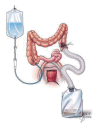Current indications and role of surgery in the management of sigmoid diverticulitis
- PMID: 20143459
- PMCID: PMC2825327
- DOI: 10.3748/wjg.v16.i7.804
Current indications and role of surgery in the management of sigmoid diverticulitis
Abstract
Sigmoid diverticulitis is a common disease which carries both a significant morbidity and a societal economic burden. This review article analyzes the current data regarding management of sigmoid diverticulitis in its variable clinical presentations. Wide-spectrum antibiotics are the standard of care for uncomplicated diverticulitis. Recently published data indicate that sigmoid diverticulitis does not mandate surgical management after the second episode of uncomplicated disease as previously recommended. Rather, a more individualized approach, taking into account frequency, severity of the attacks and their impact on quality of life, should guide the indication for surgery. On the other hand, complicated diverticular disease still requires surgical treatment in patients with acceptable comorbidity risk and remains a life-threatening condition in the case of free peritoneal perforation. Laparoscopic surgery is increasingly accepted as the surgical approach of choice for most presentations of the disease and has also been proposed in the treatment of generalized peritonitis. There is not sufficient evidence supporting any changes in the approach to management in younger patients. Conversely, the available evidence suggests that surgery should be indicated after one attack of uncomplicated disease in immunocompromised individuals. Uncommon clinical presentations of sigmoid diverticulitis and their possible association with inflammatory bowel disease are also discussed.
Figures





Similar articles
-
Defining the role of laparoscopic-assisted sigmoid colectomy for diverticulitis.Dis Colon Rectum. 2000 Dec;43(12):1726-31. doi: 10.1007/BF02236858. Dis Colon Rectum. 2000. PMID: 11156458
-
Can laparoscopically assisted sigmoid resection provide uncomplicated management even in cases of complicated diverticulitis?Surg Endosc. 2006 Jul;20(7):1055-9. doi: 10.1007/s00464-005-0529-3. Epub 2006 May 26. Surg Endosc. 2006. PMID: 16736310 Clinical Trial.
-
[Sigmoid diverticulitis. Surgical indications and timing].Chirurg. 2002 Jul;73(7):681-9. doi: 10.1007/s00104-002-0506-5. Chirurg. 2002. PMID: 12242976 German.
-
Minimally invasive and surgical management strategies tailored to the severity of acute diverticulitis.Br J Surg. 2014 Jan;101(1):e90-9. doi: 10.1002/bjs.9359. Epub 2013 Nov 21. Br J Surg. 2014. PMID: 24258427 Review.
-
[Surgical treatment of sigmoid diverticulitis].Rev Prat. 2013 Jun;63(6):827-30. Rev Prat. 2013. PMID: 23923763 Review. French.
Cited by
-
Outpatient antibiotic use and the incidence of acute appendicitis in Finland: a nationwide study from 1990-2008.Surg Infect (Larchmt). 2013 Aug;14(4):352-6. doi: 10.1089/sur.2012.069. Epub 2013 Jul 16. Surg Infect (Larchmt). 2013. PMID: 23859685 Free PMC article.
-
Laparoscopic assisted sigmoid resection for diverticular disease.Langenbecks Arch Surg. 2012 Mar;397(3):487-90. doi: 10.1007/s00423-011-0891-7. Epub 2011 Dec 30. Langenbecks Arch Surg. 2012. PMID: 22207389
-
Factors Associated with Repeated Health Resource Utilization in Patients with Diverticulitis.J Gastrointest Surg. 2017 Jan;21(1):112-120. doi: 10.1007/s11605-016-3245-5. Epub 2016 Sep 9. J Gastrointest Surg. 2017. PMID: 27613732
-
Operative rates in acute diverticulitis with concurrent small bowel obstruction.Trauma Surg Acute Care Open. 2022 Jul 6;7(1):e000925. doi: 10.1136/tsaco-2022-000925. eCollection 2022. Trauma Surg Acute Care Open. 2022. PMID: 35891678 Free PMC article.
-
Peripheral vs pedicle division in laparoscopic resection of sigmoid diverticulitis: a 10-year experience.Int J Colorectal Dis. 2018 Jul;33(7):887-894. doi: 10.1007/s00384-018-3080-0. Epub 2018 May 17. Int J Colorectal Dis. 2018. PMID: 29770846
References
-
- Etzioni DA, Mack TM, Beart RW Jr, Kaiser AM. Diverticulitis in the United States: 1998-2005: changing patterns of disease and treatment. Ann Surg. 2009;249:210–217. - PubMed
-
- Aldoori WH, Giovannucci EL, Rimm EB, Wing AL, Willett WC. Use of acetaminophen and nonsteroidal anti-inflammatory drugs: a prospective study and the risk of symptomatic diverticular disease in men. Arch Fam Med. 1998;7:255–260. - PubMed
Publication types
MeSH terms
Substances
LinkOut - more resources
Full Text Sources

